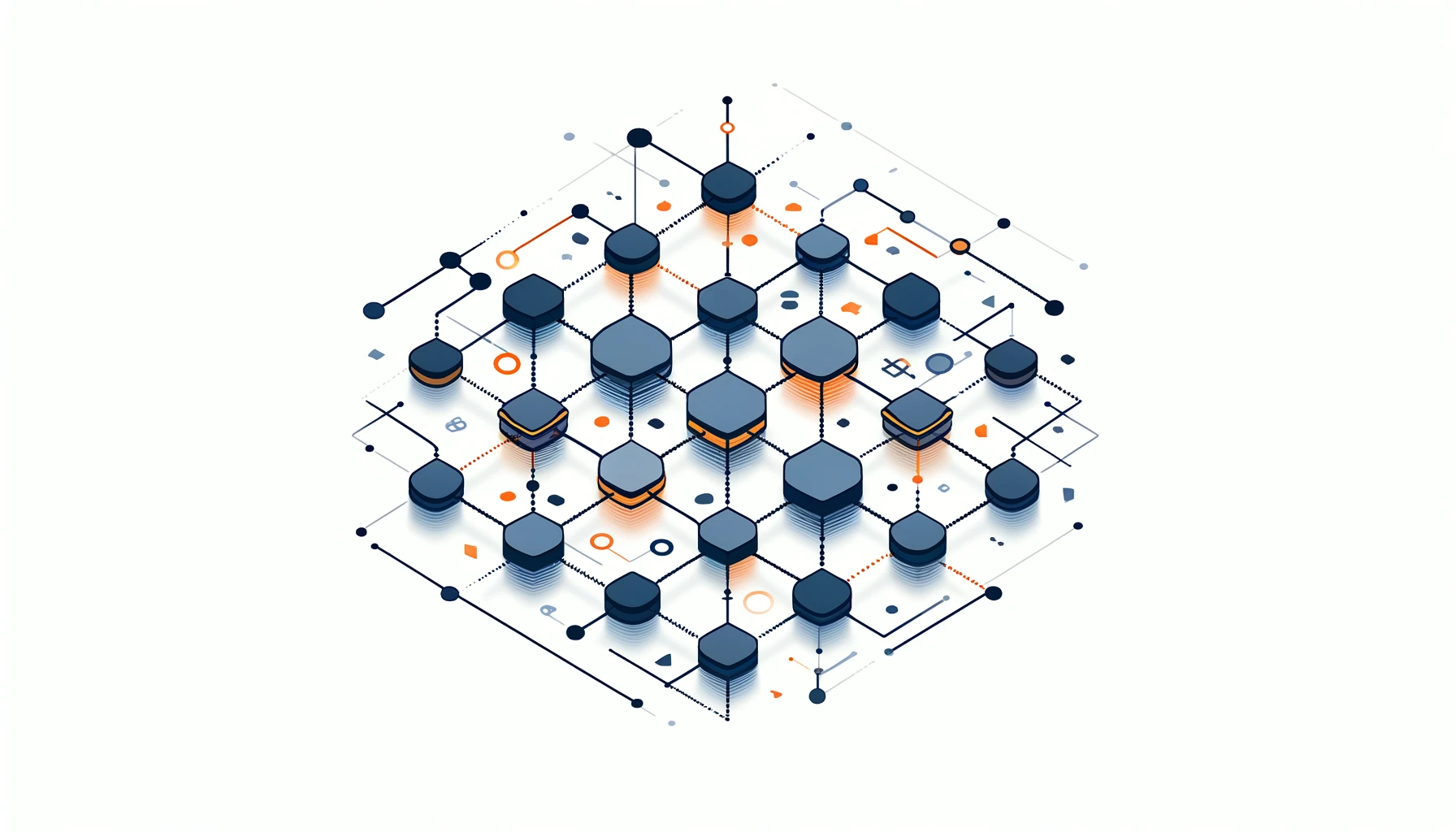
What is Data Mesh?

Introduction
Organizations in today’s data-driven world are always looking for ways to effectively store, manage, and utilize large amounts of data. Traditional centralized data storage approaches have their limitations, especially when dealing with large-scale, diverse, and rapidly growing datasets. This is where the concept of a data mesh comes into play. In this article, we will explore what a data mesh is, its advantages over centralized data storage, and how it can be applied in various domains such as the Internet of Things (IoT), smart homes, and healthcare devices.
Understanding Data Mesh
A mesh is a distributed architecture that aims to decentralize data ownership and management. Instead of storing all data in a central repository, it distributes data across multiple nodes or domains. Each domain is responsible for its own data, ensuring data quality, governance, and accessibility. This approach enables organizations to break down data silos and promote data-driven decision-making across different business units.
Zhamak Dehghani coined the term “data mesh” in 2019. Before that, concepts like domain-driven design and decentralized data ownership existed already in various contexts. Dehghani came up with the idea of the complex concept. This idea gives us a clear way to use these principles in managing data today.
Centralized vs. Distributed Data Storage
Traditionally, organizations have relied on centralized data storage systems, where you store all the data in a single location. While this approach has its merits, such as easier management and control, it also has several drawbacks. Centralized data storage can become a bottleneck when dealing with large volumes of data, leading to performance issues and scalability challenges. Moreover, it can create data silos, making it difficult for different departments to access and utilize data effectively.
In contrast, a data mesh adopts a distributed approach to data storage. Data is stored across multiple nodes or domains, each responsible for its own data. This decentralized architecture allows for better scalability, as each domain can handle its own data processing and storage independently.
It promotes data ownership and accountability by assigning each domain the responsibility of maintaining the quality and governance of its data. Each domain is responsible for ensuring the quality and governance of its data. This encourages accountability and ownership within each domain.
Data Mesh in Practice
Internet of Things (IoT)
The Internet of Things (IoT) is a prime example of where a mesh storage can be highly beneficial. IoT devices generate massive amounts of data from various sources, such as sensors, smart devices, and connected appliances. Storing and processing this data centrally can be challenging due to the sheer volume and variety of data involved.
With a data mesh, IoT data can be stored and processed at the edge, closer to the devices themselves. Each IoT device or a group of devices can act as a node in the data mesh, responsible for its own data storage and processing. This distributed approach reduces latency, improves data locality, and enables real-time decision-making. For example, a smart factory equipped with IoT sensors can use a mesh nodes to process and analyze sensor data locally, enabling quick detection of anomalies and optimizing production processes.
Smart Homes
Smart homes are another area where a mesh storage can prove valuable. A smart home consists of multiple connected devices, such as smart thermostats, security systems, and home appliances. These devices generate a significant amount of data that needs to be stored, analyzed, and acted upon.
In a smart home, a data mesh allows each device or group of devices to store and process its own data. This distributed approach ensures that data is processed locally, reducing latency and improving responsiveness. A smart thermostat can adjust settings based on nearby temperature information and user preferences. It can also consider external factors without requiring a central data storage location.
Healthcare Devices
In the healthcare industry, medical devices generate a vast amount of patient data, including vital signs, medical images, and treatment information. Storing and managing this sensitive data centrally can be challenging due to privacy concerns and regulatory requirements.
A mesh storage can assist healthcare devices in storing and processing data on the device or a specific node. This can help solve various problems. This method ensures patient data security by storing it within the healthcare facility’s network.
This lowers the risk of data breaches and unauthorized access. It also enables healthcare providers to access and analyze patient data in real-time, facilitating quick decision-making and personalized treatment plans.
Implementing a Data Mesh
Implementing a data mesh requires careful planning and the right tools. Here are a few software solutions that can help with mesh storage implementation:
- Apache Kafka: A distributed streaming platform that enables real-time data processing and event-driven architectures.
- Apache Cassandra: A highly scalable, distributed NoSQL database that provides high availability and fault tolerance.
- Apache Spark: A fast and general-purpose cluster computing system for large-scale data processing and analytics.
- Kubernetes: An open-source container orchestration platform that enables the deployment and management of distributed applications.
These tools make it easier to set up a mesh storage. They provide the infrastructure, processing power, and scalability needed for storing and managing data across different locations.
Security in a Data Mesh
Security is a critical concern in any data architecture, and a mesh concept is no exception. In a data mesh, data is distributed across multiple domains or nodes, each responsible for its own data. This decentralized approach can pose security challenges, as data is no longer stored in a single, centrally controlled repository.
To ensure security in a data mesh, several measures need to be put in place:
Access Control
Each domain or node in the data mesh should have strict access control mechanisms. This includes authentication and authorization processes to ensure that only authorized users or systems can access the data. Implement role-based access control (RBAC) to grant specific permissions based on user roles and responsibilities.
Data Encryption
The solution should encrypt the data both at rest and in transit. Encryption ensures that even if unauthorized access occurs, the data remains secure. Encryption keys should be securely managed and rotated regularly.
Data Governance
A robust data governance framework is essential in a data mesh. This includes defining data ownership, data quality standards, and data lineage. Each domain should have clear policies and procedures for data handling, including data classification, retention, and disposal.
Auditing and Monitoring
Regular auditing and monitoring of data access and activities should be implemented. This helps detect and respond to any suspicious or unauthorized activities promptly. Audit logs should be maintained for accountability and compliance purposes.
Secure Communication
Communication between nodes in a data mesh should be secured using encryption protocols such as SSL/TLS. This ensures that data transmitted between nodes remains confidential and integrity is maintained.
Reliability in a Data Mesh
Reliability is another crucial aspect of a data mesh. In a mesh architecture, ensuring the availability and consistency of data across nodes is essential. Here are some considerations for reliability in a data mesh:
Data Replication
To ensure high availability and fault tolerance, you should replicate the data across multiple nodes. This allows for data access even if one or more nodes fail. We can employ replication strategies such as synchronous or asynchronous replication.
Data Consistency
Maintaining data consistency across nodes is critical in a data mesh. Consistency ensures that all nodes have the same view of the data at any given point in time. You can use distributed consensus algorithms, such as Paxos or Raft to achieve strong consistency across nodes.
Fault Tolerance
You design the data mesh architecture so that it handles node failures gracefully. This includes mechanisms for automatic failover and recovery. If a node fails, the system should be able to detect the failure and redirect requests to available nodes seamlessly.
Data Backup and Recovery
Regular data backups should be performed to protect against data loss due to hardware failures or disasters. Backup strategies should be defined and tested regularly. In the event of data loss, a well-defined recovery process should be in place to restore data from backups.
Monitoring and Alerting
Continuous monitoring of the data mesh infrastructure is essential for ensuring reliability. Monitoring should cover various aspects, such as node health, data integrity, and performance metrics. Alerts should be configured to notify administrators of any issues or anomalies promptly.
To further enhance the security and reliability of a data mesh, specialized tools and platforms can be utilized. For instance, DataSunrise provides various tools for protecting data, checking it, hiding it, and following rules. These tools can work together with a data mesh system.
These tools provide additional security features such as real-time monitoring, data masking, and detailed access controls. These features are designed to assist organizations in meeting their security and compliance requirements.
Conclusion
A data mesh is a modern approach to storing and managing data. It shifts away from centralized methods and adopts a distributed architecture. A data mesh offers benefits like improved scalability, data locality, and real-time processing. It achieves this by decentralizing data ownership and enabling domain-driven data management.
Organizations are facing challenges in managing and utilizing large datasets, and a mesh storage offers a promising solution. A data mesh can assist organizations in different industries like IoT, smart homes, and healthcare. It helps them unlock the full potential of their data and make suitable decisions.
DataSunrise offers versatile tools for data security, audit rules, masking, and compliance to safeguard your data’s integrity. These tools are exceptional and flexible. They help protect and maintain the integrity of your data.
Their comprehensive solutions can seamlessly integrate with your data mesh implementation, providing an added layer of security and control. We invite you to visit the DataSunrise website and request an online demo and explore how our cutting-edge solutions can enhance your data mesh architecture.
